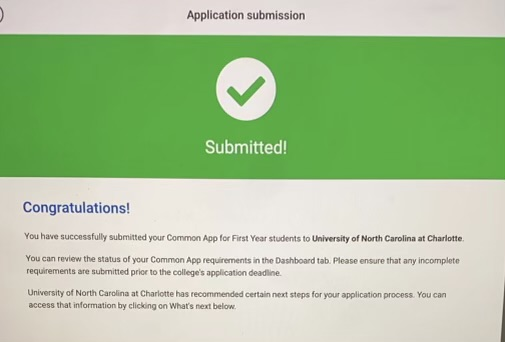There are different ways to apply to college, including Early Action, Regular Decision, and Early Decision.
Colleges tend to favor the early applicants who apply through Early Action.
When a student submits through Early Action, the deadline varies from October to December depending on the school.
“I submitted all my applications on October 15 — partly because a few of my schools’ deadlines were on this day, and the rest I wanted to get out of the way,” said Cecily Vammino, senior.
For a lot of North Carolina colleges (including NC State, UNCW, Appalachian State etc.), the early action date was November 1. Some students scrambled to submit their applications after a long Halloween weekend.
“I submitted all my applications right on November 1, but this day was a difficult deadline because November 1st sneaks up on you after a long October month,” said Liam Heiden, senior.
Pros of Early Action
Knocking out all the college applications in the first semester leaves more time for the student to focus on other activities. These can be college-related, like working to get scholarships. There is also more time to focus on current school work, or anything else taking up room in a student’s schedule.
Submitting earlier means receiving acceptance letters earlier. Most students who apply early will know all where they have been accepted to by earliest, beginning of second semester. This gives a while to know and weigh out your options. This is your future – some may need a longer time than others to make this life-changing decision.
“With Early Action, I get to hear back earlier which is important to me. I like to know my options,” said Vammino.
Although there are rumors, applying Early Action does not increase your chances of acceptance as much as it seems. These are still the first applications a college admissions officer reviews — so for a somewhat competitive college, if a high number of applicants are accepted through the first round, it becomes more competitive to get in after with the limited spots left.
Cons of Early Action
Students’ materials must be ready much sooner in order to meet the earlier deadline. Someone with weak time management skills might struggle to get everything in order for submission. It’s difficult to manage tests, homework, and add college applications in the mix. Between the essay, teacher recommendations, and short answers, a student may have to begin the process even earlier (i.e. cutting into their summer break).
Submitting college applications earlier also eliminates a semester’s worth of grades and activities to apply with. Ideally, a student’s best work should be submitted. If your GPA is going to rise significantly from fall semester classes, waiting until second semester could be a better option.
Regular Decision
Those who choose to apply for Regular Decision have a later deadline to submit their application, typically anywhere from December to March.
For the North Carolina schools like NC State, UNCW, and Appalachian State, the deadline is January 15.
Pros of Regular Decision
The extra submission time gives an applicant longer to work on various things.
A very big decision to make is what the student wants to major in. Extra time provides more room to explore what their interests are, and what they want to study. If one is indecisive between majors, there is more to choose between the two or more.
It also may help a student who is planning to take/retake the ACT or SAT for a higher score. With the extra month or two provided by the later submission date, there is more time to increase scores. The higher the score, the better chance of acceptance, or even a scholarship.
Regular decision also gives a student more time to perfect their essays – a huge part of the application.
Cons of Regular Decision
Because of the later deadline, a student will not hear back regarding their acceptance until later as well. For some, it is important to be aware of their options earlier on. If this is the case, the Regular Decision route would not be beneficial.
May 1 is “National College Decision Day”. Applicants commit to a college by this deadline — they may do this any time before to secure their spot as well.
Because a student receives their information about where they got accepted in the spring rather than winter, less time is provided to make this decision. In two months at the most, options must be weighed out. Applying Early Action gives a lengthier period of time to think about it and come to a final decision.
“I prefer to hear back earlier rather than later, which I’d consider a con of applying Regular Decision for the one school that I am, Duke,” said Vinay Sadhwani, senior.
His decision to apply through regular decision to Duke is because this particular university’s only other option is Early Decision.
This third and less common option for college applications requires a student to attend the college once they get accepted. The difference is Early Action is non-binding, while ED is binding.
“I’m not 100% sure I want to go to this school. If I apply Early Decision, I have to attend here. Hence my decision to submit later despite the cons,” said Sadhwani.
Pros of Early Decision
If accepted early, you will know where you are attending college very early on – this can prepare a student for their future, and eliminates indecisiveness.
Cons of Early Decision
The binding nature of this can serve as a disadvantage, as students cannot compare other financial aid awards from other colleges.
Similar to early action, you must have all your application materials ready to send in earlier. This gives less time to perfect scores, essays, and grades.

Hi! My name is Maddy and I am a staff writer for the Mycenaean. I love to travel, watch sunsets, and listen to music.

Leave a Reply